 Image search results - "rag" Image search results - "rag" |
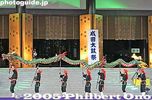
Taiko troupe from OkinawaThis group stole the show with a dragon dance, lion dogs, and eisa taiko drummers.
|
|

Dragon boat
|
|
|
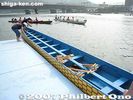
Dragon boat
|
|

Free rides on this dragon boat were also provided.
|
|

Dragon boat
|
|
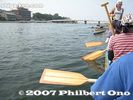
Rowing on the dragon boat
|
|

Dragon boat going to the Seta-Karahashi Bridge.
|
|
|
|

A taiko drummer sits at the front of the dragon boat.
|
|
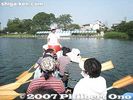
We rowed according to the taiko drum beat.
|
|

Memorial for the war dead
|
|
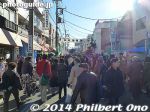
The Setagaya Boro-ichi is held on Dec. 15-16 and Jan. 15-16 annually.A large outdoor flea market of used and new clothing, antiques, household items, food, plants, and crafts.
|
|
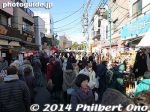
All sorts of knickknacks on sale. Some 700 stalls line the a few narrow streets near Setagaya and Kamimachi Stations on the Tokyu Setagaya Line.It can get pretty crowded when it's not raining.
|
|
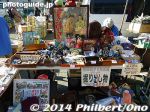
Boro-ichi started over 400 years ago in 1578 when Odawara daimyo Lord Hojo Ujimasa opened a market place in this area. It started out selling old clothing and used goods, so it came to be called "boro-ichi" (rag market). Today, vendors also sell antiques, used books, food, household items, and all kinds of knick-knacks.
|
|
|
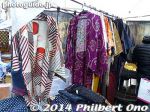
Old kimono.
|
|
|
|
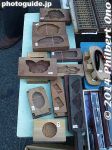
Molds
|
|
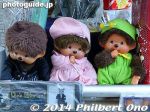
Monchhichi
|
|
|
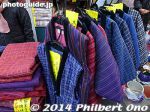
Hanten
|
|
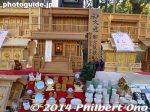
Household shrines
|
|
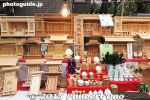
Household shrines, kamidana
|
|
|
|
|
|
|
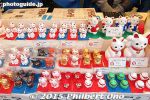
Maneki neko or beckoning cat
|
|
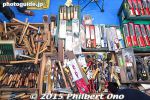
Tools and knives
|
|

Wristwatches
|
|
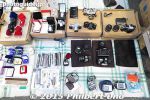
Small cameras
|
|

Cutting boards
|
|
|
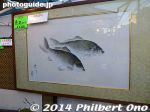
Gyotaku print (Fish print)
|
|
|
|
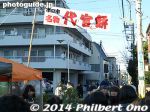
Way to daikan mochi.
|
|
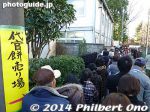
Long line to buy daikan mochi, one of the famous things about the boro-ichi.
|
|
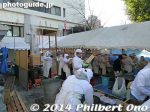
Making daikan mochi on site.
|
|
|
|

Three flavors of daikan mochi.
|
|
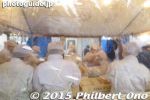
Busy preparing and packaging the mochi.
|
|
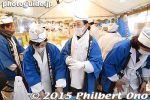
Mochi sellers
|
|
|
|
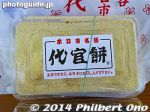
Kinako (sweet soybean flour) daikan mochi
|
|

Azuki daikan mochi.
|
|
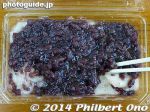
They really pile on the azuki.
|
|
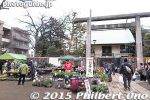
Near the shrine are potted flowers for sale.
|
|
|
|
|
|
|
|
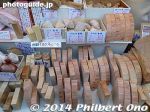
Very fragrant pieces of wood such as hinoki cypress.
|
|
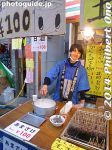
Amazake
|
|
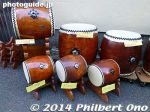
Taiko drums for sale
|
|
|
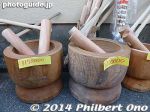
Mochi mortars for sale.
|
|
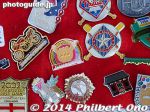
Pins for collectors.
|
|
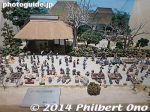
Setagaya Boro-ichi in the old days.
|
|
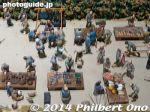
Setagaya Boro-ichi in the old days.
|
|
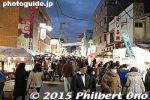
Also crowded at night.
|
|

Mt. Toragozen is near JR Torahime Station on the Hokuriku Line. Mt. Toragozen is an easy walk. MAP
|
|

Cherry blossoms almost right outside the train station.
|
|
|

Weeping cherry blossoms on the way to Toragozen-yama.
|
|
|
|
|
|

More cherry blossoms along the river. Amazing how much cherry blossoms there are, but so few people enjoying them.
|
|
|
|
|
|

Buddha statue in a cemetery framed by cherry blossoms.
|
|

Cherry blossoms even in the middle of the river. So picturesque.
|
|
|
|

Toragozen-yama cherry blossoms
|
|

Cherry blossoms near Toragozen-yama in Nagahama.
|
|
|
|
|
|

Cherry blossoms in the middle of the river near Toragozen-yama, Nagahama.
|
|
|
|
|
|
|
|
|
|
|
|
|
|
|
|
|
|
|
|
|
|

Near Toragozen-yama
|
|
|
|
|
|

Gansan Daishi temple in the distance near Toragozen-yama, Nagahama.
|
|
|
|
|

Entrance to Toragozen-yama in spring during cherry blossoms season in mid-April.
|
|
|
|
|
|
|
|

Tumulus on Toragozen-yama.
|
|
|
|
|
|
|
|
|

Yaai Shrine torii on Toragozen-yama. 矢愛神社
|
|
|
|

Yaai Shrine torii on Toragozen-yama.
|
|
|

Yaai Shrine
|
|
|
|

About Yaai Shrine torii on Toragozen-yama. Dedicated to a water god since people in this area needed water which did not come easily in the old days. 矢愛神社
|
|
|
|

Toragozen is a historic battle site during warlord Oda Nobunaga's siege of Azai Nagamasa's Odani Castle in October 1573. Before the siege, Nobunaga placed his troops on Mt. Toragozen with clear sights on Mt. Odani.
|
|

Top of Mt. Toragozen
|
|
|
|
|
|
|
|
|
|
|
|
|
|
|
|
|
|
|
|
|
|
|
|
|
|
|

Toragozen-yama camp grounds.
|
|
|
|
|

JR Hokuriku Line train as seen from Mt. Toragozen.
|
|
|
|

Toragozen-yama camp grounds.
|
|
|

Mt. Ibuki as seen from Mt. Toragozen-yama.
|
|
|
|
|
|

Mt. Toragozen, Nagahama
|
|
|
|
|
|

Only a few local people enjoyed the fantastic cherry blossoms on Toragozen-yama.
|
|
|
|
|
|

Maruyama Tumulus 丸山古墳
|
|
|

Maruyama Tumulus 丸山古墳
|
|

Maruyama Tumulus 丸山古墳
|
|

Jiyukan Hall is a gathering place with rooms for rent and an exhibition space. 時遊館
|
|
|
|
|
|
|
|

More pictures of Mt. Toragozen taken years earlier.
|
|

Foot of Mt. Toragozen-yama.
|
|

Trail entrance to Toragozen-yama. It actually leads to Yaai Shrine.
|
|

Map of Toragozen-yama.
|
|
|
|

Yaai Shrine torii on Toragozen-yama.
|
|

Path to Yaai Shrine on Toragozen-yama.
|
|
|

Yaai Shrine
|
|

In the old days, Yaai Shrine had rituals where they shot arrows. 矢愛神社
|
|

Statue of a Japanese archer at Yaai Shrine, Toragozen-yama. 矢愛神社
|
|

Statue of a Japanese archer at Yaai Shrine, Toragozen-yama, Torahime, Shiga.
|
|

Yaai Shrine main hall
|
|

About Yaai Shrine 矢愛神社
|
|

Tumulus on Toragozen-yama.
|
|

Tumulus on Toragozen-yama.
|
|
|
|
|
|

Trail to camping grounds..
|
|

Kobo Daishi Road
|
|
|
|
|

Trail to camping grounds
|
|

Toragozen-yama Educational Camping facilities on Toragozen-yama.
|
|

Map of camping facilities. Cabins in two wings.
|
|

Lookout tower on Toragozen-yama.
|
|

Lookout deck
|
|

View of Toragozen-yama from the lookout deck.
|
|

View of Torahime from Toragozen-yama.
|
|

Mt. Ibuki and signs
|
|

Camping grounds for tents.
|
|
|

Camping grounds for tents.
|
|

Lookout point
|
|
|
|

View from Toragozen-yama toward Lake Biwa. Hokuriku Line in foreground.
|
|

View of Mt. Toragozen-yama from the Hokuriku Line train. Cherry blossoms on the mountain.
|
|

Toragozen-yama was the site of a battle.
|
|
|
|
|
|
|

The Nagaragawa River ukai cormorant fishing is held nightly from May 11 to Oct. 15 except during the Full Moon and if the river overflows. You can buy tickets and board the viewing boats here, next to Nagarabashi Bridge. 鵜飼観覧船のりば
|
|

Although there is cormorant fishing in other parts of Japan, Gifu's Nagara River ukai cormorant fishing is most famous because it is connected to the Imperial family. Statue of a ukai cormorant fishing master called an "usho." 鵜匠の像
|
|

Ticket office for ukai cormorant fishing viewing boats. Behind it is Nagara River and boat dock. You can buy tickets on the day you want to view the cormorant fishing. Pamphlets in English are available. 鵜飼観覧船事務所
|
|

You have several options: Course/Cruise A is slightly more expensive (3300 yen) than Course B (3000 yen) since it allows you to be on the boat for a longer time. The 6:15 pm departure time is earlier, so it gives you time to eat dinner on the boat.On weekends and holidays, the 3300 yen price is the same for both Course A and B.
|
|

You can bring your own food and drinks on the boat. Next to the ticket office is this stone moument for a TV program which declared a song about Nagara River ukai cormorant fishing to be a national favorite for many years.
|
|

Ukai-related poems. There's even one composed by Basho: おもしろうて やがて悲しき 鵜飼かな。 Gifu's Nagara River ukai cormorant fishing has a 1300-year history. It is recorded in the Nihon Shoki (Chronicle of Japan) and Kojiki
|
|

Boat harbor for ukai viewing boats. The two boats in the foreground are restroom boats. Ukai cormorant fishing is a traditional fishing technique all but replaced by more advanced fishing methods. So it is now mainly for tourists.
|
|

Restroom boat. During the cormorant fishing, this toilet boat is parked near the viewing boats for your convenience.
|
|

Ukai cormorant fishing viewing boat. You don't need to go as a group. You can go by yourself and just ride with other passengers. There are also boats for women only, families only, and couples only.
|
|

If you have a group of 15 or more, it would be cheaper to charter a boat to view the cormorant fishing. Some of the viewing boats are also handicapped-accessible.
|
|

Dancing boat where dancers entertain people before the ukai fishing. 踊り舟
|
|

At the boat dock (next to Nagarabashi Bridge) at 5:45 pm, one of the six ukai cormorant fishing masters give a short talk about ukai fishing. The crowd gathers for the talk.
|
|

Ukai cormorant fishing master Sugiyama Ichisaburo comes to give the ukai talk. The basket has two cormorant birds. Nagara River in Gifu has six ukai cormorant fishing masters. All of them appear nightly. 杉山市三郎
|
|

First he explains about the fishing master's costume, starting with his cap (kazaori-eboshi) made of hemp cloth. It's actually a flat piece of black or navy blue cloth wrapped around his head to protect his hair from the fire. 風折烏帽子
|
|

The cap protrudes upward to make room for the topknot which the men used to have in the old days. His shirt (ryofuku) is made of cotton. He also has a fire-protection vest (muneate) that has a pocket. 漁服(りょうふく)胸あて(むあて)
|
|
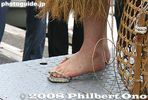
His footwear is a pair of half-slippers (ashinaka) made of straw (handmade by the fishing master). It is half the usual length. It prevents him from slipping on the fish oil and water. 足半(あしなか)
|
|

He took out one of the cormorants from the basket cage. In Japanese, the bird is called umi'u. They normally fish in the ocean as opposed to the kawa'u river cormorant which are smaller and have been devastating to the fish in Lake Biwa.
|
|

He puts in ayu sweetfish into the cormorant's mouth. Nagara River's six cormorant fishing masters are employees of the Imperial Household Agency (Ceremonies Dept.). They are national government employees. 海鵜
|
|

There is a ring around the bird's throat, preventing it from swallowing the fish. (The bird can still swallow smaller fish.) The cormorants are caught in the wild in Hitachi, Ibaraki Prefecture and trained for ukai fishing in Gifu. 鵜
|
|
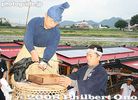
The bird then spits out the fish. The person on the right is the fishing master's son being groomed to take over his father's job. The fishing master has been doing this for 50 years. It is a hereditary position and occupation. 鮎
|
|

The fishing master's handmade skirt (koshimino) is made of straw. It functions as a raincoat and provides warmth. He makes and wears out four or five skirts each year. Underneath is just shorts. 腰蓑(こしみの)
|
|
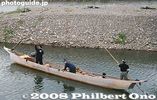
The ukai fishing master's ukai cormorant fishing boat is called ubune. Accompanied by an assistant (middle) called the nakanori and the steerer (at rear) called tomonori. About 13 meters long. 鵜舟(うぶね)= 鵜匠+供乗り(とものり)
|
|

After the ukai talk, passengers start to board the ukai viewing boats at 6:15 pm. Course B passengers will board at 6:45 pm or 7:15 pm. Course B is for people who just want to see the cormorant fishing, and don't care to spend much time on the boat.
|
|

With passengers aboard, the boats depart one after another, heading upstream.
|
|

The viewing boats are called yakata-bune. They come in different sizes. 屋形船
|
|

The smaller yakata-bune, like this one, is human-powered.
|
|

The larger yakata-bune has a silent, battery-powered outboard motor. Notice the solar panels on the roof. 屋形船
|
|

Ukai viewing boats head upstream to where the boats are parked next to the river shore.
|
|
|
|